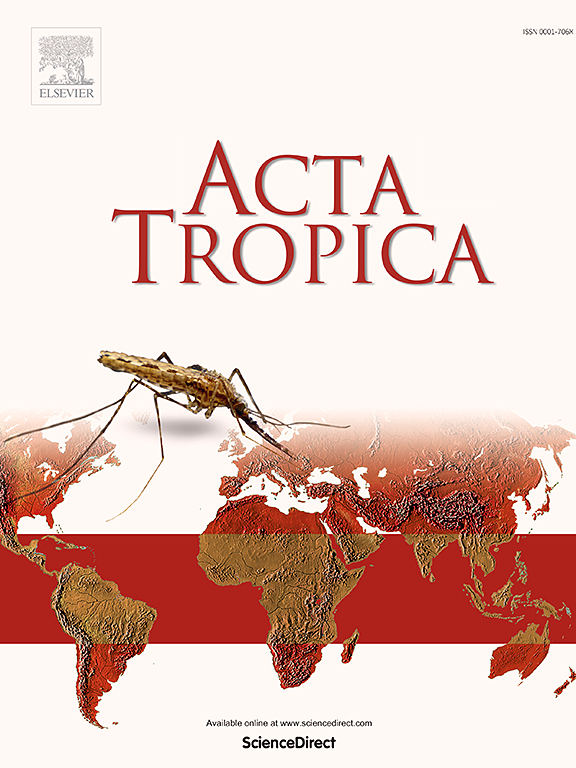Comparative study on the utility of automated chemiluminescence immunoassay for NS1 antigen-based dengue diagnosis
IF 2.1
3区 医学
Q2 PARASITOLOGY
引用次数: 0
Abstract
With newer dengue outbreaks extending to regions that were previously unaffected, about half of the world's population is now at risk of dengue infection. This scale of dengue spread and its undistinguishing primary fever symptom demands embracing automated high-throughput diagnostic techniques for quicker confirmatory diagnosis which otherwise requires time, cost and skill intensive reverse transcription-polymerase chain reaction (RT-PCR). Magnetic bead-based automated chemiluminescence immunoassay (CLIA) is one potential platform that has proven its diagnostic potential for different diseases. However, adoption of CLIA for dengue diagnosis demands extensive validation for widespread implementation. To this end, we evaluated the diagnostic performance of CLIA in comparison with routine dengue diagnostic approaches such as rapid diagnostic test (RDT) and RT-PCR. RDT and CLIA detected the presence of dengue non-structural protein 1 (NS1) antigen while RT-PCR detected the presence of viral RNA. From the analysis of 204 samples, the dengue test positive percentage was 17.6 %, 16.7 % and 19.6 % by RDT, CLIA and RT-PCR methods, respectively. CLIA exhibited a sensitivity of 77.5 %, specificity of 98.17 % and a Cohen's kappa agreement (κ) value of 0.802 with RT-PCR. In addition, CLIA also exhibited a high κ-value of 0.931 with RDT. These findings show the reliability of NS1 antigen detection using automated CLIA for dengue diagnosis. This supports the potential to adopt high-throughput automated CLIA for dengue diagnosis when resources and expertise required to meet the need for quick test result turnaround during outbreaks may be limited.

自动化学发光免疫分析法在基于NS1抗原的登革热诊断中的应用比较研究。
随着新的登革热疫情蔓延到以前未受影响的地区,世界上大约一半的人口现在面临登革热感染的风险。登革热传播的规模及其难以区分的初级发热症状要求采用自动化高通量诊断技术,以便更快地确诊,否则需要时间、成本和技能密集型的逆转录聚合酶链反应(RT-PCR)。基于磁珠的自动化学发光免疫分析(CLIA)是一种潜在的诊断平台,已被证明具有不同疾病的诊断潜力。然而,采用CLIA进行登革热诊断需要广泛的验证才能广泛实施。为此,我们将CLIA的诊断性能与常规登革热诊断方法(如快速诊断试验(RDT)和RT-PCR)进行了比较。RDT和CLIA检测登革热非结构蛋白1 (NS1)抗原的存在,RT-PCR检测病毒RNA的存在。204份样本中,RDT法、CLIA法和RT-PCR法登革热检测阳性率分别为17.6%、16.7%和19.6%。CLIA与RT-PCR的敏感性为77.5%,特异性为98.17%,Cohen’s kappa agreement (κ)值为0.802。此外,CLIA在RDT下也表现出较高的κ值0.931。这些结果表明使用自动CLIA检测NS1抗原诊断登革热的可靠性。在疫情爆发期间满足快速检测结果周转所需的资源和专业知识可能有限的情况下,这支持了采用高通量自动化CLIA进行登革热诊断的潜力。
本文章由计算机程序翻译,如有差异,请以英文原文为准。
求助全文
约1分钟内获得全文
求助全文
来源期刊

Acta tropica
医学-寄生虫学
CiteScore
5.40
自引率
11.10%
发文量
383
审稿时长
37 days
期刊介绍:
Acta Tropica, is an international journal on infectious diseases that covers public health sciences and biomedical research with particular emphasis on topics relevant to human and animal health in the tropics and the subtropics.
 求助内容:
求助内容: 应助结果提醒方式:
应助结果提醒方式:


